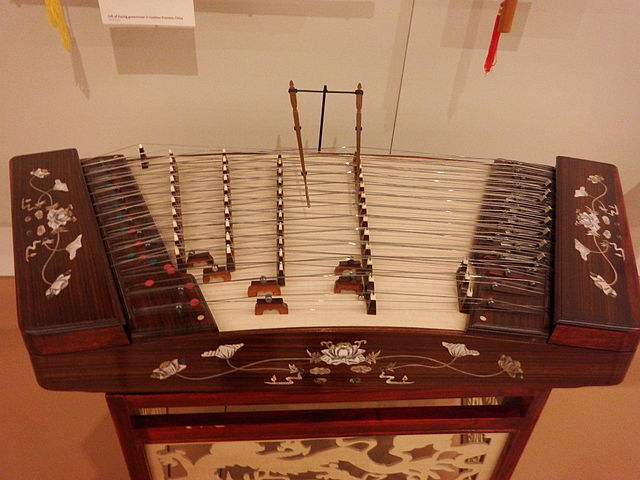Difference between revisions of "Language/Multiple-languages/Culture/Traditional-Musical-Instruments:-Eastern-Asia"
< Language | Multiple-languages | Culture
Jump to navigation
Jump to search
(→Gǔqín) |
|||
| Line 56: | Line 56: | ||
<youtube>MvxbfpuccXo</youtube> | <youtube>MvxbfpuccXo</youtube> | ||
=== ''Gǔzhēng'' === | |||
{| class="wikitable" | |||
!Chinese | |||
|- | |||
|古箏/古筝 | |||
ㄍㄨˇ ㄓㄥ; gu<sup>2</sup> zang<sup>1</sup> | |||
|} | |||
Han: | |||
https://upload.wikimedia.org/wikipedia/commons/thumb/e/e3/Guzheng1.jpg/640px-Guzheng1.jpg | |||
<youtube>xuj7kY4QCr8</youtube> | |||
=== ''Haegeum'' === | === ''Haegeum'' === | ||
Revision as of 03:46, 17 May 2023

This page features translations of traditional musical instrument terms in different languages from Eastern Asia, accompanied by pictures and videos.
String
Bipa
| Japanese |
|---|
| 비파
琵琶 |
Korean:

Biwa
| Japanese |
|---|
| 琵琶
びわ |
Yamato:

Èrhú
| Chinese |
|---|
| 二胡
ㄦˋ ㄏㄨˊ; ji6 wu4 |
Han:

Gǔqín
| Chinese |
|---|
| 古琴
ㄍㄨˇ ㄑㄧㄣˊ; gu2 kam4 |
Han:

Gǔzhēng
| Chinese |
|---|
| 古箏/古筝
ㄍㄨˇ ㄓㄥ; gu2 zang1 |
Han:

Haegeum
| Korean |
|---|
| 해금
奚琴 |
Korean:

Morin Khuur
| Mongolian |
|---|
| Морин хуур
ᠮᠣᠷᠢᠨ ᠬᠣᠭᠣᠷ |
Mongolian:

Pípá
| Chinese |
|---|
| 琵琶
ㄆㄧˊ ㄆㄚˊ; pei4 paa4 |
Han:

Yángqín
| Chinese |
|---|
| 揚琴/扬琴
ㄧㄤˊ ㄑㄧㄣˊ; joeng4 kam4 |
Han:

Other lessons
- Traditional Symbols and Motifs: Southeastern Asia
- FLOSS programs with Anki support
- Most Important Dates in World History
- Traditional Symbols and Motifs: Eastern Europe
- Best Guitarists
- Ordering with Letters
- Traditional Architectures: Polynesia
- Best Singers
- Websites of Classified Advertisement
- Traditional Symbols and Motifs: Northern Africa
- Traditional Architectures: Eastern Asia
- Most Famous Non–Contemporary Artists
- Traditional Architectures: Western Africa
- Internet resources for learning specific languages
- Texts and Audios under a Public License